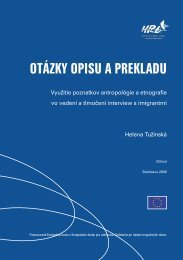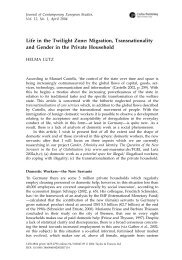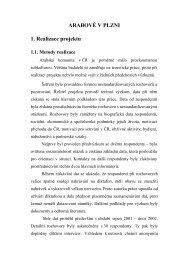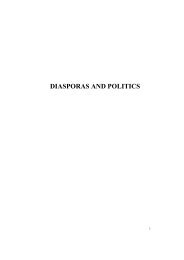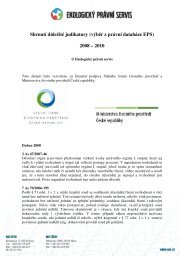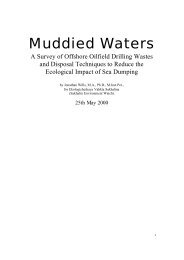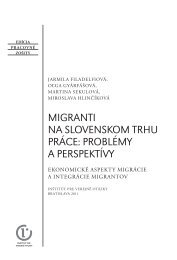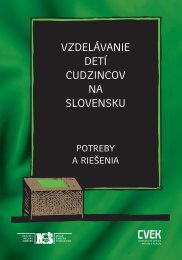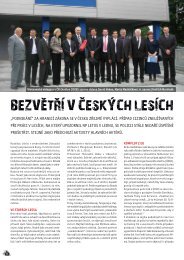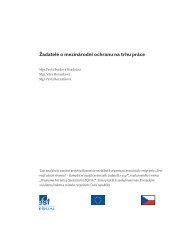Migration Processes in Central and Eastern Europe - Multiple Choices
Migration Processes in Central and Eastern Europe - Multiple Choices
Migration Processes in Central and Eastern Europe - Multiple Choices
You also want an ePaper? Increase the reach of your titles
YUMPU automatically turns print PDFs into web optimized ePapers that Google loves.
———————————————————————————————————————————————————————————————<br />
Normative <strong>and</strong> Methodological Discussion of <strong>Migration</strong> <strong>and</strong> Integration<br />
———————————————————————————————————————————————————————————————<br />
68<br />
————————————————————————————<br />
How Long Should<br />
Immigrants Wait<br />
to Become<br />
Citizens?<br />
—————————————————————————————<br />
Petr Kafka<br />
This work exam<strong>in</strong>es citizenship laws <strong>in</strong> the Czech<br />
Republic, Slovakia, Hungary <strong>and</strong> Pol<strong>and</strong>. More<br />
specifically, it is a normative study of one of the<br />
most salient conditions of naturalisation: the<br />
length of required residence. There are other important<br />
issues regard<strong>in</strong>g naturalisation, but I feel the discussion<br />
will be more manageable if we focus on one set of issues.<br />
The broader question beh<strong>in</strong>d this <strong>in</strong>quiry is what should be<br />
the naturalisation requirements <strong>in</strong> liberal democratic countries<br />
that these four Member States of the EU claim to be. 1<br />
In this paper, I argue that while different countries<br />
are entitled to their specific nationality laws <strong>and</strong> there is a<br />
range of morally permissible regulations, there are also<br />
limits on the restrictions <strong>and</strong> requirements of naturalisation<br />
these countries adopt. I suggest that while it may be justified<br />
to require longer residence record (three to eight years) as<br />
a pre-requisite of obta<strong>in</strong><strong>in</strong>g citizenship, it is unreasonable<br />
to dem<strong>and</strong> a similar or longer period of temporary residence<br />
before grant<strong>in</strong>g permanent residence without count<strong>in</strong>g<br />
at least some portion of this temporary stay towards the<br />
citizenship requirement.<br />
This paper offers a normative reflection on one<br />
of the naturalisation policies <strong>in</strong> <strong>Central</strong> <strong>Europe</strong> <strong>and</strong> the<br />
implications these specific measures have for <strong>in</strong>tegration<br />
of immigrants.<br />
DIVERSE POLICIES OR ONE SET OF<br />
HARMONISED NATIONALITY LAWS IN THE EU?<br />
Before delv<strong>in</strong>g <strong>in</strong>to a discussion of the residence<br />
requirements, let me clarify the legal context of the <strong>Europe</strong>an<br />
legislation <strong>in</strong> which the nationality laws are set. It is common<br />
knowledge that there are at least two types of policies<br />
concern<strong>in</strong>g migration. The first set of policies regulate the<br />
entry of immigrants <strong>in</strong>to the receiv<strong>in</strong>g state. Rules concern<strong>in</strong>g<br />
visas, border control, asylum, <strong>and</strong> undocumented migration<br />
belong <strong>in</strong> such a category. These policies are usually<br />
referred to as immigration policies. The second type of<br />
policies, frequently labelled <strong>in</strong>tegration policies, are measures<br />
def<strong>in</strong><strong>in</strong>g treatment of migrants once they are <strong>in</strong> the<br />
country. These are measures concern<strong>in</strong>g the rights <strong>and</strong><br />
duties of particular categories of immigrants <strong>and</strong> conditions<br />
of ga<strong>in</strong><strong>in</strong>g different legal statuses, <strong>in</strong>clud<strong>in</strong>g citizenship.<br />
This term may also refer to measures help<strong>in</strong>g immigrants<br />
settle <strong>in</strong> the new society, but this area is beyond the scope<br />
of my analysis. Follow<strong>in</strong>g the Treaty of Amsterdam, immigration<br />
policies were transferred as the first pillar of the<br />
<strong>Europe</strong>an community under the jurisdiction of the<br />
<strong>Europe</strong>an Commission. The EC has put forward a number<br />
of regulations, directives, proposals <strong>and</strong> recommendations<br />
concern<strong>in</strong>g migration that serve as st<strong>and</strong>ards for the<br />
Member States. However, most of these EC measures are<br />
of the first type, that is they regulate entry of immigrants.<br />
Treatment of immigrants who made it through the border<br />
control primarily rema<strong>in</strong>s with<strong>in</strong> the jurisdiction of the <strong>in</strong>dividual<br />
Member States.<br />
That does not mean that there are no <strong>Europe</strong>an<br />
st<strong>and</strong>ards <strong>in</strong> the area of treatment of immigrants. There are<br />
two important directives with<strong>in</strong> the framework of the<br />
Community Law, namely on the family reunification <strong>and</strong><br />
the status of third-country nationals who are long-term<br />
residents. In addition, there is the 1999 Convention on<br />
Nationality put together by the Council of <strong>Europe</strong>, which<br />
<strong>in</strong>cludes many <strong>in</strong>strumental regulations concern<strong>in</strong>g treatment<br />
of migrants.<br />
However, there are three crucial th<strong>in</strong>gs we need to<br />
say about these <strong>Europe</strong>an st<strong>and</strong>ards. First, these norms do<br />
not cover the complexity of immigrants' life <strong>in</strong> the receiv<strong>in</strong>g<br />
country the way citizenship laws <strong>in</strong> <strong>in</strong>dividual countries do.<br />
Second, as we will see, these st<strong>and</strong>ards are often def<strong>in</strong>ed <strong>in</strong><br />
rather general <strong>and</strong> ambiguous terms. Third, only 7 out of<br />
the 25 EU countries have signed <strong>and</strong> ratified the<br />
Convention on Nationality. This means that 18 EU countries<br />
are not bound by this st<strong>and</strong>ard-sett<strong>in</strong>g Convention.<br />
Consequently, there is considerable room for the Member<br />
States to def<strong>in</strong>e their own treatment of migrants.<br />
Of course, the format of this paper will not allow<br />
me to touch on all the important issues related to citizenship<br />
laws. What I decided to do <strong>in</strong>stead is to exam<strong>in</strong>e one set<br />
of controversial requirements regard<strong>in</strong>g naturalisation<br />
<strong>and</strong> consider some of the challenges these residence<br />
requirements produce.<br />
HOW LONG IS, AND HOW LONG SHOULD BE,<br />
THE STAY REQUIREMENT?<br />
Residence requirements for naturalisation vary<br />
considerably from country to country with<strong>in</strong> the <strong>Europe</strong>an<br />
Union. Just to give you a sense of the outliers, the requirement<br />
can range from fifteen years <strong>in</strong> Austria to only four<br />
<strong>Migration</strong> <strong>Processes</strong> <strong>in</strong> <strong>Central</strong> <strong>and</strong> <strong>Eastern</strong> <strong>Europe</strong>: Unpack<strong>in</strong>g the Diversity



